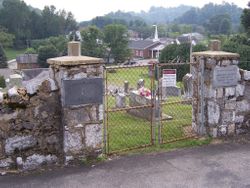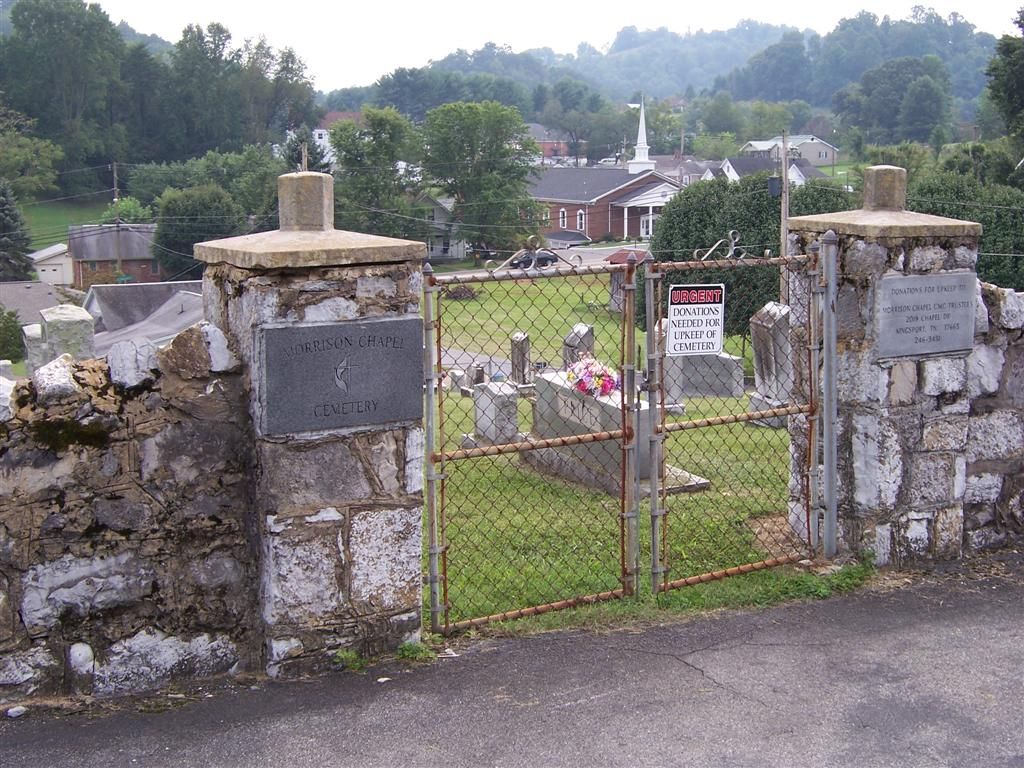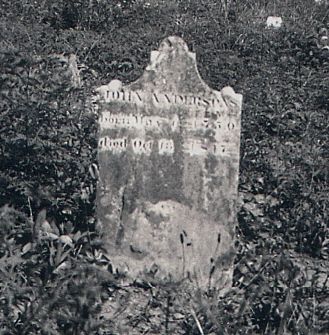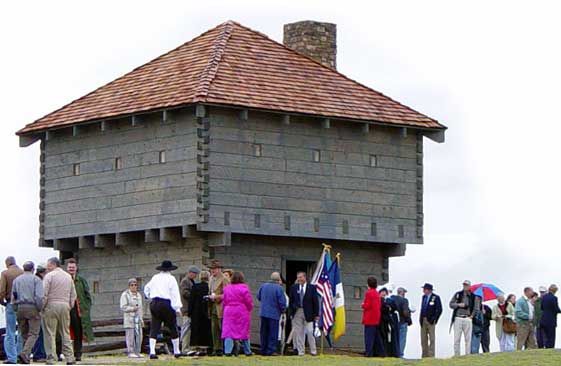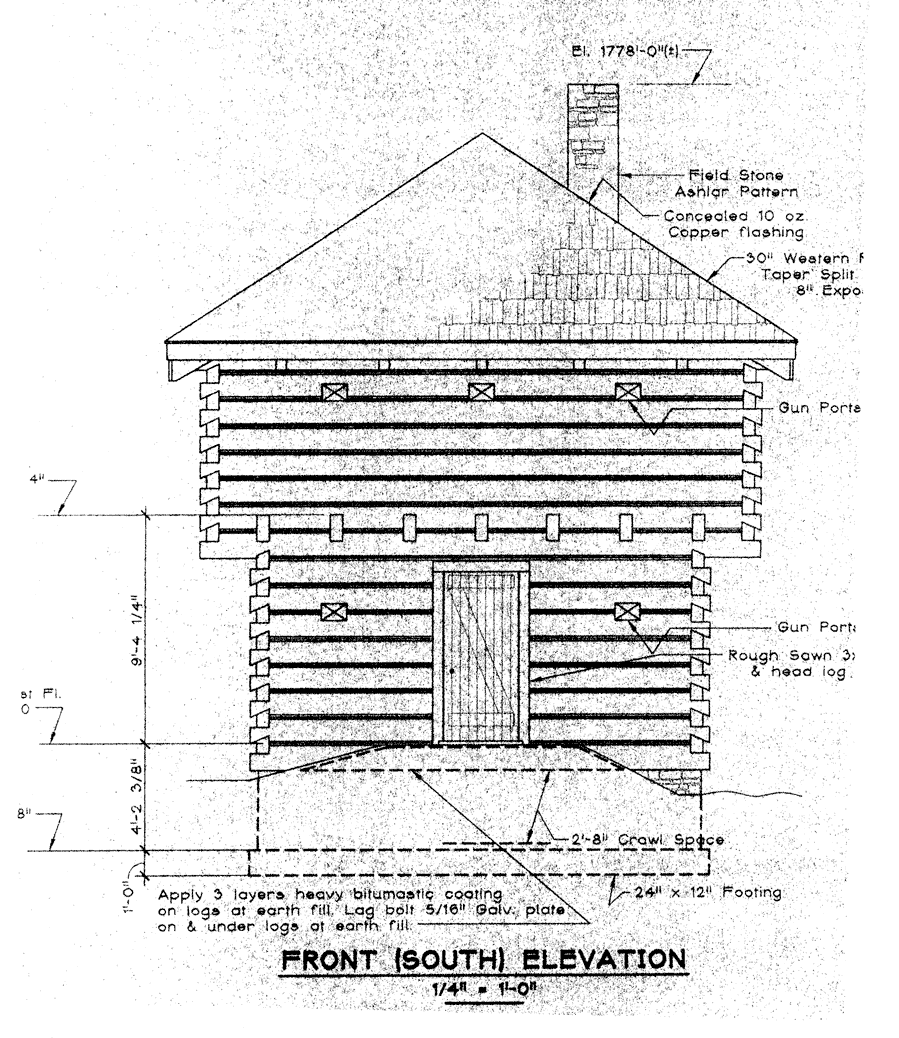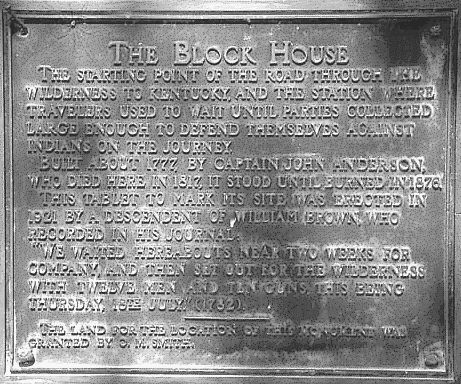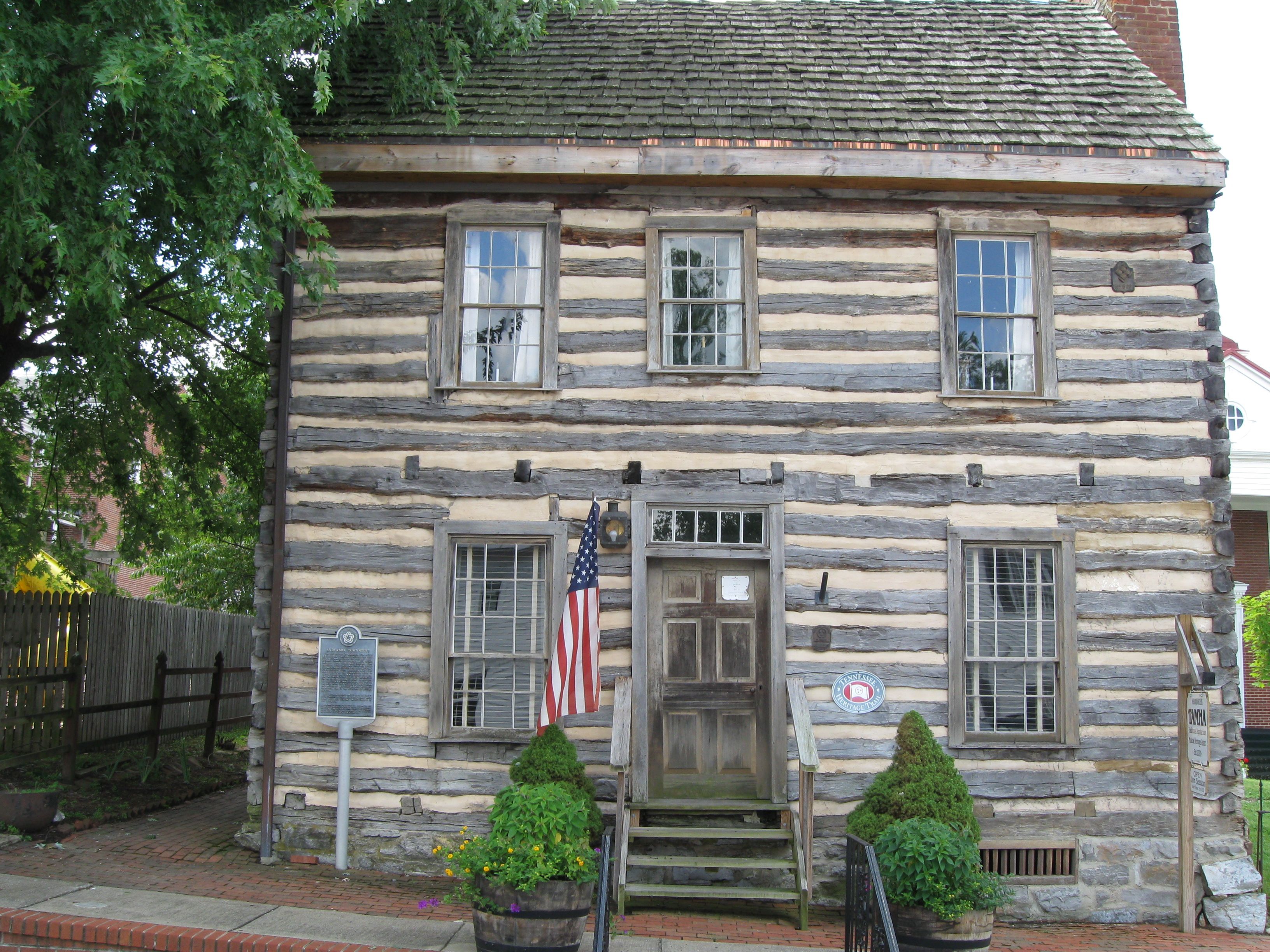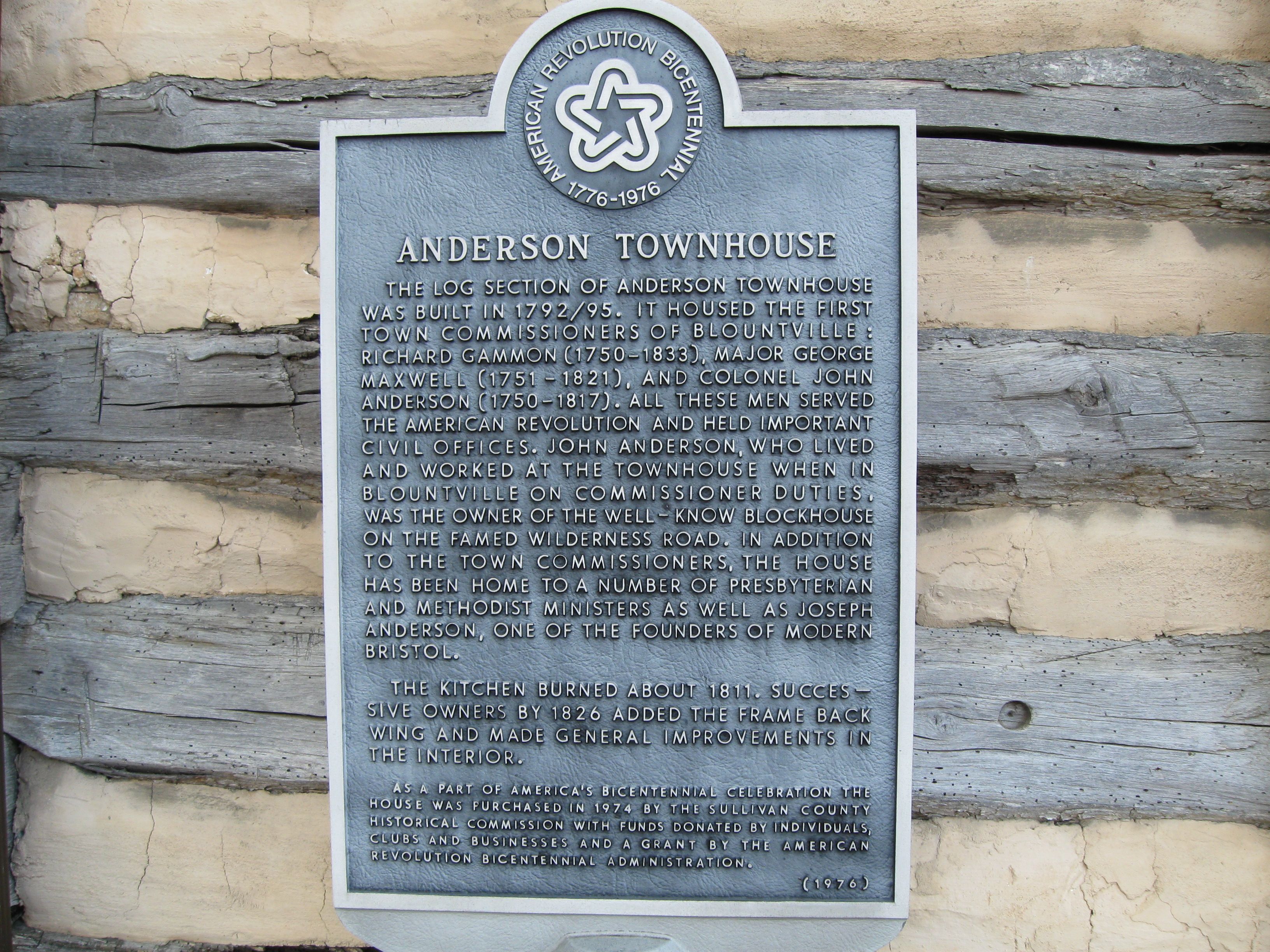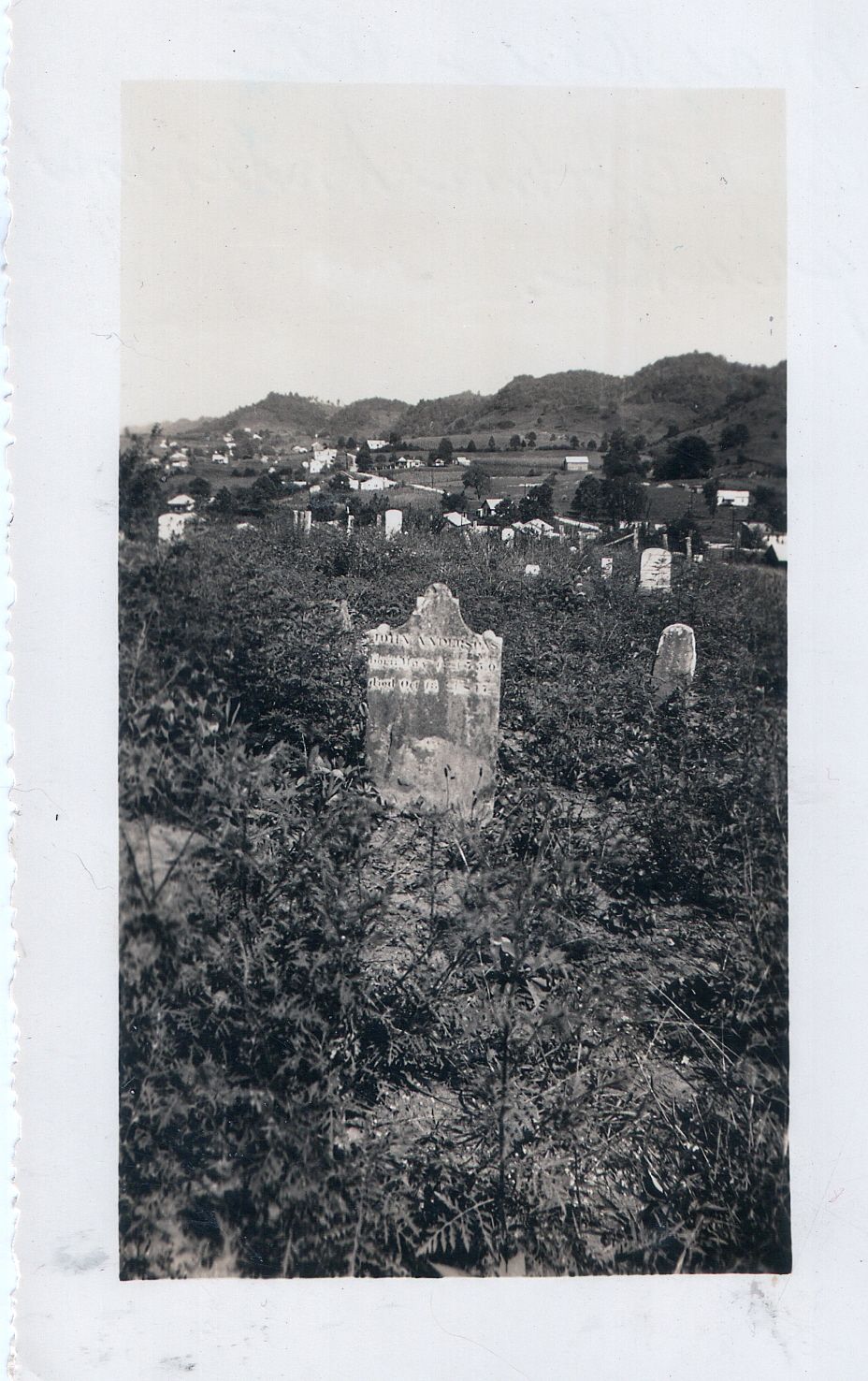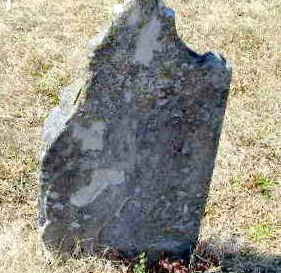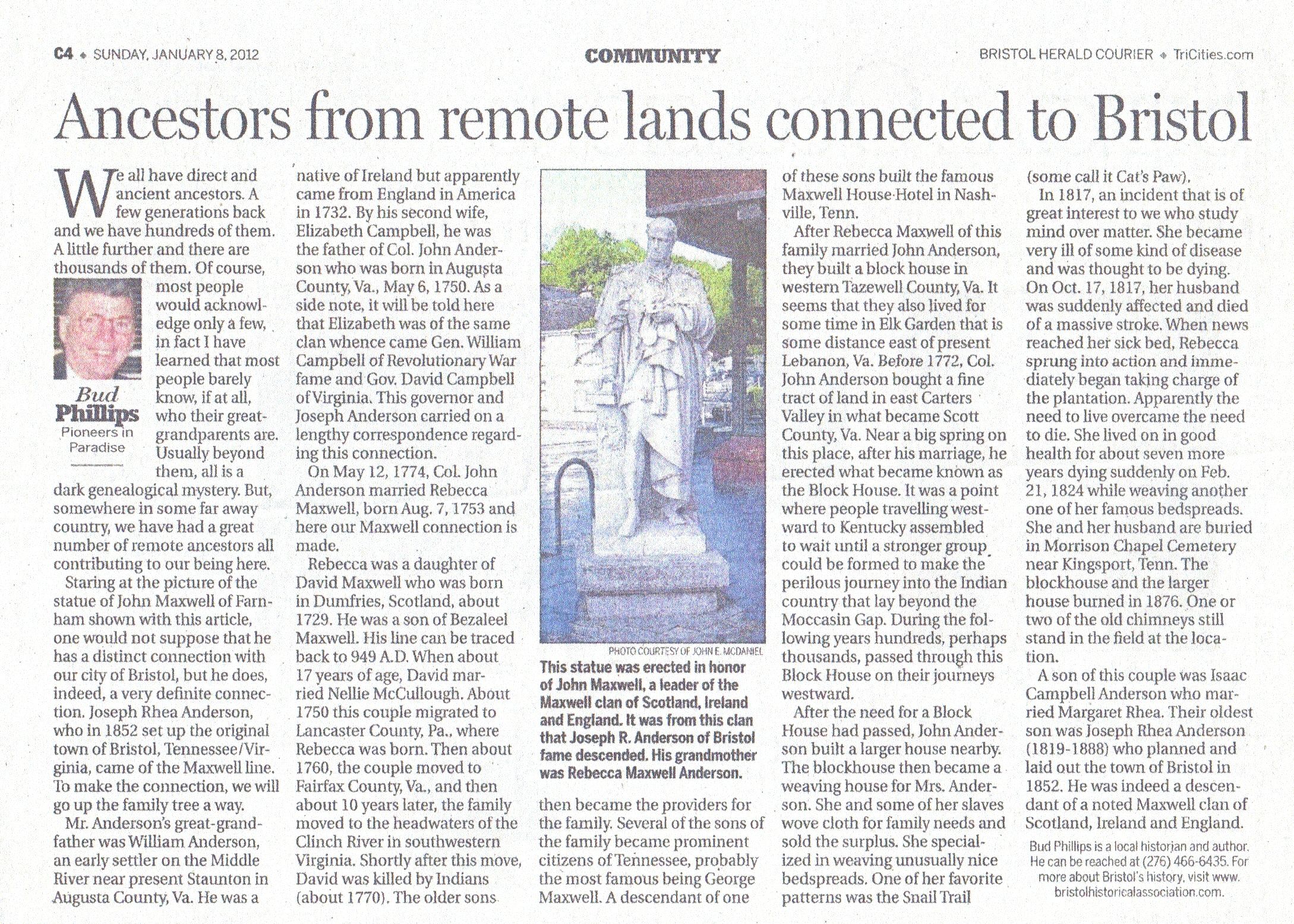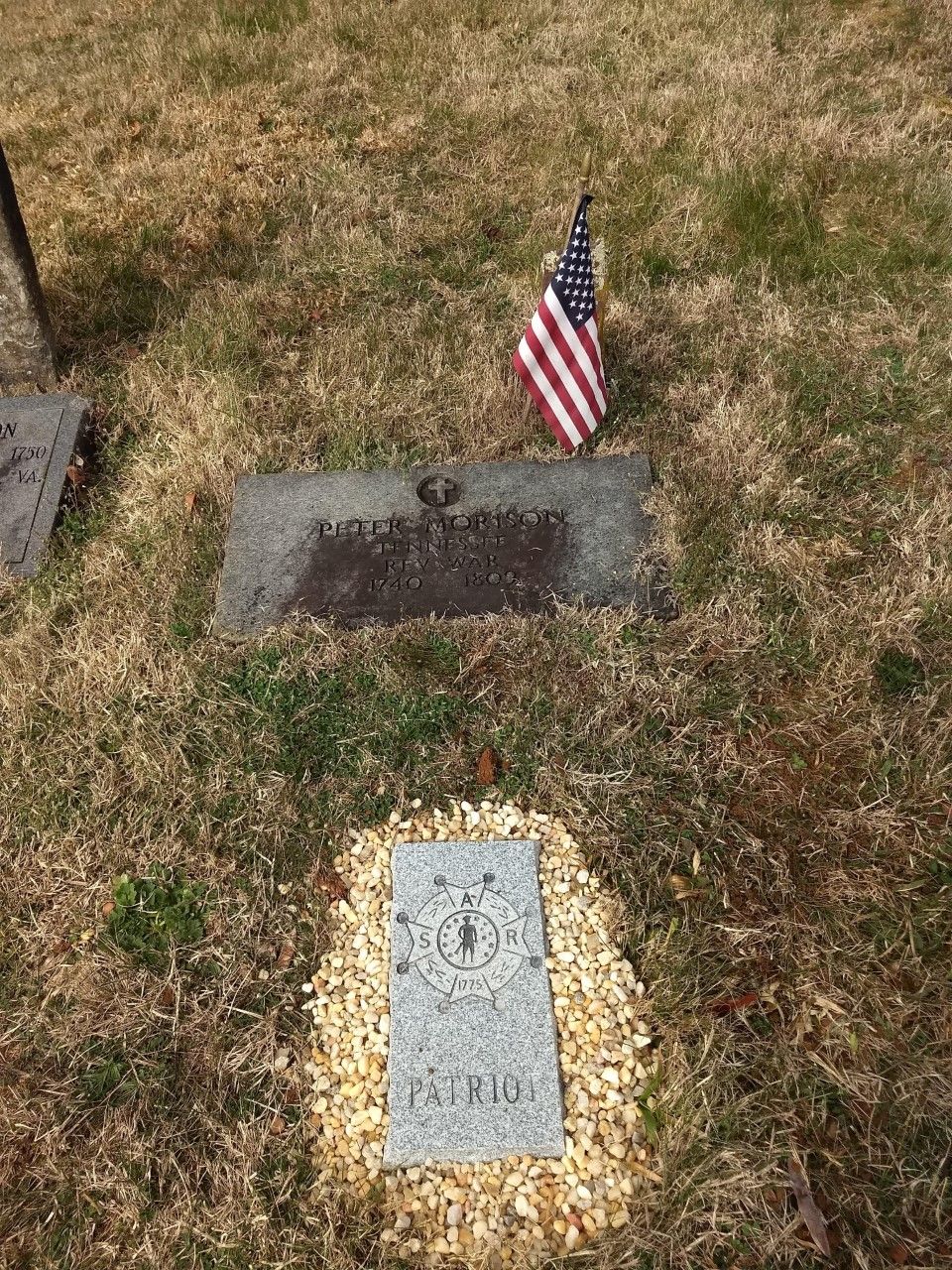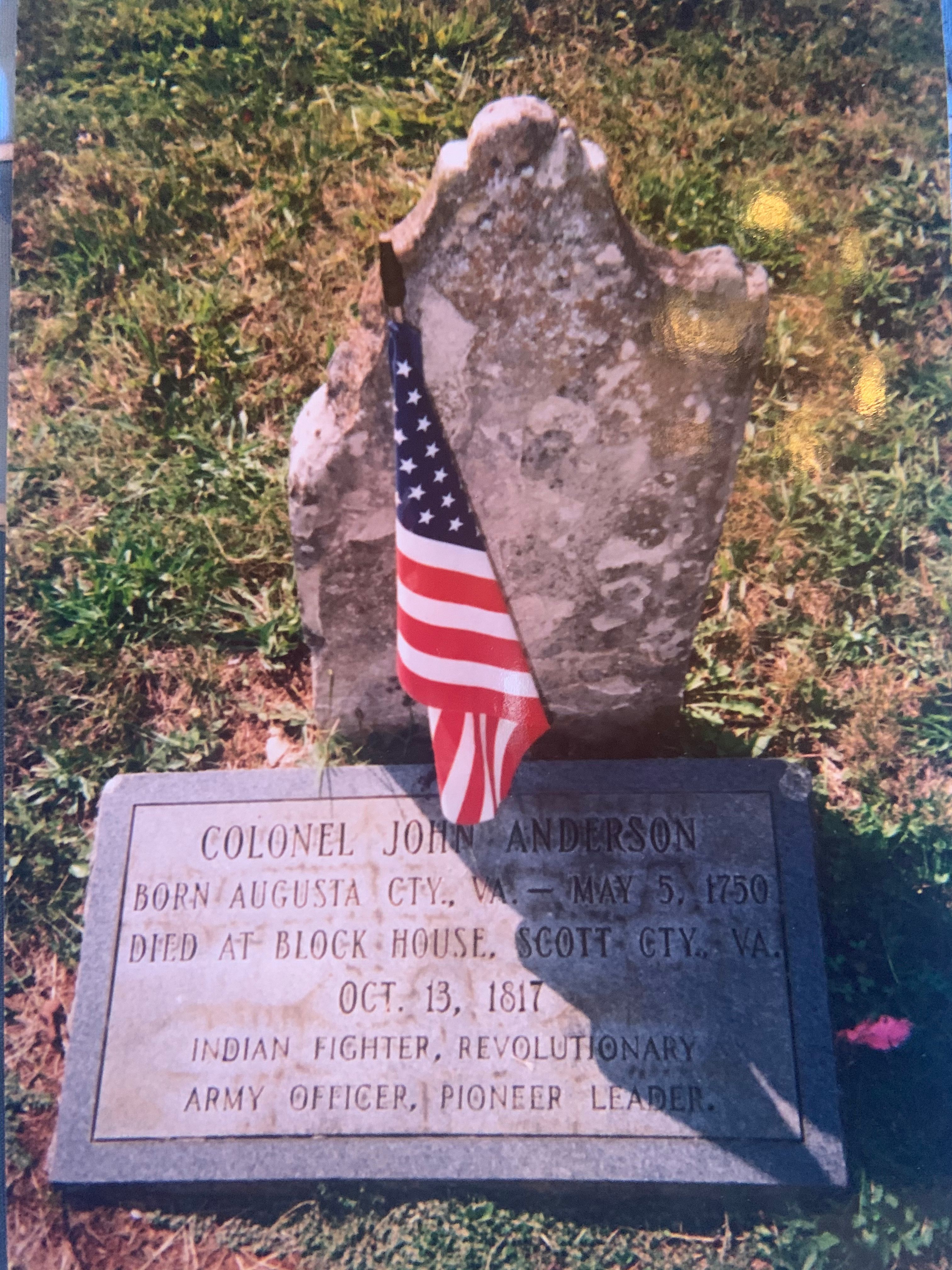Brother of Mary "Polley" (Anderson) Skillern, Robert Anderson (b. circa 1749), Rebecca (Anderson) [Wallace] Grigsby, Elizabeth (Anderson) Anderson, George Anderson, William Anderson, Jr., Robert Anderson (b. 1760), Alexander "Alex" Anderson, and Jean/Jane Anderson.
Half-brother of Margaret (Anderson) Clendenen. She was the only child of William Anderson, Sr. and Mary (Reid) Anderson, his first wife.
Half-brother of an unknown infant, b. circa 1745 and d. circa 1745 in Augusta County, VA. This was the only child of William Anderson, Sr. and Hannah (Christian) Anderson, his second wife.
Husband of Rebecca Malissa (Maxwell) [Hall] Anderson.
Father of William Anderson [my 3rd great-grandfather], Lieut. Col. John Anderson, II, Mary Alias "Polly" (Anderson) Skillern, Margaret Elizabeth "Betsy" (Anderson) Christian, Audley "Andy" Anderson, Sarah "Sally" (Anderson) Galbraith, Col. Isaac Campbell Anderson, Sr., and Jane (Anderson) Henninger.
Col. John Anderson, Sr., Builder of the Blockhouse
by William Anderson (with minor editing by Sammy Boyd)
The Wilderness Road Blockhouse in Natural Tunnel State Park is a reproduction of the original blockhouse built by an early pioneer, John Anderson, in 1775. Anderson's eventful life included not just his role as the Blockhouse proprietor, but also service as a regional militia leader and judge.
Born in 1750, Anderson was the son of one of the first settlers of the Shenandoah Valley, William Anderson, Sr., who farmed several thousand acres near Staunton, Virginia. The Andersons were part of a group of immigrants known as "Scots-Irish" because they were Scottish in ancestry but came to America from Northern Ireland. The Scots-Irish were hardy and stubborn people, qualities Anderson would need to survive first the French and Indian War in his youth and later the long conflicts in the Holston region.
Anderson first explored the Holston area in 1769, when it was still a wilderness, and moved to the area in 1773 with a wave of new settlers. Anderson did not build the Blockhouse, however, until two years later. In the meantime, he nearly lost his life. During Dunsmore's War, a short-lived conflict with the Shawnee in late 1774, Anderson served as an ensign in the local militia attached to Blackmore's Fort, left behind to protect against attacks on the settlements. When a raiding party caught the fort defenders outside the fort, Anderson and another defender left the security of the fort under fire to try to rescue a downed comrade who was about to be scalped. The militia colonel in charge of the region reported that "the Indians like to had done Anderson's job, having struck into the stockade a few inches from his head." Daniel Boone led a rescue party to the fort the day after the attack and served as captain over the local fort defense for the rest of Dunsmore's War. Boone and George Rogers Clarke were two of the heroes of the era. Anderson undoubtedly knew and worked with them in the defense of the western frontier.
When he was discharged from his militia duty, Anderson married his fiancee, Rebecca Maxwell on January 12, 1775. Needing a place to raise his family, he selected a piece of land at the end of Carter's Valley, the farthest settlement into the Holston wilderness. This location, wittingly or not, placed Anderson squarely in the path of any native raids coming across Big Moccasin Gap from the west. On this spot he built the famous Blockhouse in the spring of 1775. For the next twenty-five years, Anderson's Blockhouse served as the starting point for parties crossing the Wilderness Trail to Kentucky.
Anderson is best known for his role as the Blockhouse owner, but he was also a successful farmer and one of the area's leading citizens. Following his service at Blackmore's Fort, Anderson likely fought in the Battle of Long Island Flats, one of the first battles of the Revolutionary War. In early 1777, Governor Patrick Henry of the new state of Virginia appointed Anderson as one of the first members of the county court of newly formed Washington County, and as captain of the County militia. After 1779, due to a boundary dispute, Anderson and the Blockhouse became part of North Carolina, where he served as Lieutenant Colonel in the Sullivan County militia. Anderson is believed to have participated in at least two campaigns into native territory during the Revolutionary War. He may also have fought in the key Battle of Kings Mountain in 1780 but the records are unclear. In Virginia, he is often referred to as "Captain John Anderson," his rank in the Virginia militia, but several researchers refer to him as "Colonel John Anderson" based on his later rank.
When his state affiliation shifted to North Carolina, Anderson continued to serve as judge on the Sullivan County Court. In 1783, a group led by John Sevier tried to establish a new State of Franklin that would have encompassed the Blockhouse. Anderson found himself on the side of the supporters of the new state and even served for a short time as one of three state justices. Many residents of the area opposed the state, and the dispute reached violent proportions on occasions. At one point the opponents raided Anderson's court, drove the justices out, and took all their records. Anderson's brother-in-law, George Maxwell, led the military forces of the opponents.
In the 1780s the Blockhouse became important in the defense of Kentucky, the "dark and bloody land" where the Shawnee and Cherokee fought bitterly to stop the settlement of their hunting grounds. George Rogers Clark and other leaders used the Blockhouse to store ammunition destined for Kentucky, and Anderson provided hospitality to various officers and government agents traveling back and forth. In 1789 native raids increased in the region, in one instance resulting in one local individual losing his wife and all of his ten children to death or capture. Anderson's status among the military leaders made him the logical choice to write to Col. Arthur Campbell seeking assistance. In this letter, the only known surviving example of Anderson's handwriting, Anderson reports on a Mr. Johnson who "had his family, which consisted of his wife and eleven children, all killed and taken except two." Anderson rather searingly questions why the region's residents "guarded our frontiers in the time of the late war, when we were attacked on both sides, and now can get no help."
In the 1800s, due to shifting state boundaries, Anderson found himself back in Virginia. In a mark of the high respect area residents held Anderson, the citizens of new Scott County elected him Sheriff, the first officer appointed, even though he was 65 years old at the time. He died two years later while trying to bring cool water from a distant spring to his ill wife. His son Isaac became a leader of the new county. Anderson and his wife raised eight children and had sixty-four grandchildren. One of those grandchildren, Joseph Rhea Anderson (1819-1888), founded Bristol, Tennessee. The Blockhouse burned in 1876.
Anderson never held political office and never followed the adventurists like Boone into new territory in Kentucky and elsewhere. Instead, he settled into his life at the Blockhouse, the only home he and Rebecca ever knew, and provided a life of dedicated service to his local community. The many descendants of the travelers over the Kentucky road can thank him in part for the lives their ancestors were able to create.
Col. John Anderson, Sr. was my 4th great-grandfather through the Anderson family of Scott County, VA and Bledsoe County, Tennessee.∼Capt. John Anderson, the Revolutionary ancestor of the line here traced, was born May 5, 1750. In Augusta County, Virginia, and was the son of William and Mary Rei Anderson.
About the year 1773, John Anderson moved to the farthest white settlement In southwest Virginia and located at the "Block House," an old fort at the head of Carter's valley, in what is now Scott county, Virginia.
lie took an active part in the affairs of the frontier and was frequently engaged In conflicts with the Indians, who infested this locality
. lie is mentioned as one of the men at Fort Blackmore In 1774, the year of the Point Pleasant campaign, and was appointed ensign on Aug. 10,1774, under Capt. Looney, In the troops which took part in Dunmore's war.
On Jan. 12, 1775, John Anderson married Rebecca Maxwell, who was born Aug. 7.1753, In Augusta county, Virginia, and died Feb. 21 1824. She was a sister of George, Jesse and David Maxwell, who were Revolutionary soldiers and who were pioneers in the early settlement of Tennessee.
John and Rebecca (Maxwell) Anderson settled on Clinch river In what became Washington county, Virginia, where, according to the records of Washington county, he acquired a large amount of land. He afterward extended his possessions to include the "Block House" tract, where they Went to make their home and spent the remainder of their days.
"Block House" History Recalled,
The "Block House" was one of the notable stopping places on the old Wilderness road to Kentucky, and, according to William Allen Pusey, in his exhaustive work on "The Wilderness Road to Kentucky," pages 88-96, It was established "about 1777, or perhaps even in 1775, when Boone's party went out, by Capt. John Anderson, who lived in it from that time until his death."
The "Block House" was located in Carter's valley, at a point where the hills, opening Into a valley half a mile wide and a mile long, form a pleasant spot in a rough country, The fort site was determined, as was the custom, by the presence of a fine spring, This famous "Block House" was the last station on the old Kentucky road before it passed through Moccasin gap, gateway to the
Indian country. Roads from north and south going west converged here. and it was at this point that travelers to Kentucky gathered to form parties for the hazardous journey to the new country beyond the mountains.
Twice the Anderson family was driven by Indian attacks from the "Block House" and Was forced to find shelter in a fort at the present site of Abingdon.
On Dec. 21, 1776, Gov. Patrick Henry issued a commission of peace and dedimus for Washington county, by which John Anderson , and other Justices of the Peace were appointed for the new county, and on Jan.28. 1777, the county was organized. when John Anderson produced his commission and took the oath of justice, administered by Col. Arthur Campbell.
John Anderson was a member of the first court of Washington county, Virginia, and was present sit the first meeting, which was held at Black's fort (now Abandon), on the last Tuesday In January, 1777.
On Feb. 26, 1777, the court proceeded to recommend to the officers of Washington county to the governor of Virginia. They were duly commissioned, John Anderson, Gent., produced a commission from his excellency, the governor. bearing the date 16th May, 1777, appointing him captain of the militia of the county of Washington and took the required oath of office.
On Jan. 29, 1777. John Anderson was appointed to take the list of tithables and quantity of taxable land from Maj. Anthony Bledsoe "as low as there are settlers." Maj. Bledsoe lived east of Kingsport Tenn., and this would Indicate that Capt. Anderson was located at this time at the block house'.
On May 20, 1777, John Anderson was allowed by the county court of Washington, VA, two diets for the use of the Washington militia under the command of Capt. Newell on their march to Powell's valley, and also one hog, for the same, The stock mark of John Anderson was recorded at the same session of court.
Serves in Revolution
Capt. John Anderson served in the Revolutionary war and his company was in the regiment of Virginia militia commanded by Col. William Campbell in 1780 and 1781.
In 1780 Capt. John Anderson was named a justice of the peace of Sullivan county, NC. At this time the boundary line between Virginia and western North Carolina was being disputed and the Block House was in the disputed strip, so that several prominent families in this section participated in public affairs of both states.
In the diary of John Rhea It Is recorded that "John Anderson was appointed by the legislature of the territory south of the Ohio river, with George Maxwell and Richard Gammon, as commissioners in the year 1795, to lay off the courthouse town of Sullivan county, and at the same time they or the legislature named it Blountsville."
When Scott county, Virginia, was formed in 1814 the Block House fell into the new county. Capt, John Anderson was chosen sheriff of Scott county, a position he held until his death.
Capt. John Anderson died at the "Block House," In Scott county. Virginia, Oct. 13, 1817, and was buried in the Morrison graveyard, about five miles southeast of Gate City. Va.. where his grave may yet be seen.
The will of Capt. John Anderson is on file in Scott county, Virginia. and is recorded in book 1. page 80.
Brother of Mary "Polley" (Anderson) Skillern, Robert Anderson (b. circa 1749), Rebecca (Anderson) [Wallace] Grigsby, Elizabeth (Anderson) Anderson, George Anderson, William Anderson, Jr., Robert Anderson (b. 1760), Alexander "Alex" Anderson, and Jean/Jane Anderson.
Half-brother of Margaret (Anderson) Clendenen. She was the only child of William Anderson, Sr. and Mary (Reid) Anderson, his first wife.
Half-brother of an unknown infant, b. circa 1745 and d. circa 1745 in Augusta County, VA. This was the only child of William Anderson, Sr. and Hannah (Christian) Anderson, his second wife.
Husband of Rebecca Malissa (Maxwell) [Hall] Anderson.
Father of William Anderson [my 3rd great-grandfather], Lieut. Col. John Anderson, II, Mary Alias "Polly" (Anderson) Skillern, Margaret Elizabeth "Betsy" (Anderson) Christian, Audley "Andy" Anderson, Sarah "Sally" (Anderson) Galbraith, Col. Isaac Campbell Anderson, Sr., and Jane (Anderson) Henninger.
Col. John Anderson, Sr., Builder of the Blockhouse
by William Anderson (with minor editing by Sammy Boyd)
The Wilderness Road Blockhouse in Natural Tunnel State Park is a reproduction of the original blockhouse built by an early pioneer, John Anderson, in 1775. Anderson's eventful life included not just his role as the Blockhouse proprietor, but also service as a regional militia leader and judge.
Born in 1750, Anderson was the son of one of the first settlers of the Shenandoah Valley, William Anderson, Sr., who farmed several thousand acres near Staunton, Virginia. The Andersons were part of a group of immigrants known as "Scots-Irish" because they were Scottish in ancestry but came to America from Northern Ireland. The Scots-Irish were hardy and stubborn people, qualities Anderson would need to survive first the French and Indian War in his youth and later the long conflicts in the Holston region.
Anderson first explored the Holston area in 1769, when it was still a wilderness, and moved to the area in 1773 with a wave of new settlers. Anderson did not build the Blockhouse, however, until two years later. In the meantime, he nearly lost his life. During Dunsmore's War, a short-lived conflict with the Shawnee in late 1774, Anderson served as an ensign in the local militia attached to Blackmore's Fort, left behind to protect against attacks on the settlements. When a raiding party caught the fort defenders outside the fort, Anderson and another defender left the security of the fort under fire to try to rescue a downed comrade who was about to be scalped. The militia colonel in charge of the region reported that "the Indians like to had done Anderson's job, having struck into the stockade a few inches from his head." Daniel Boone led a rescue party to the fort the day after the attack and served as captain over the local fort defense for the rest of Dunsmore's War. Boone and George Rogers Clarke were two of the heroes of the era. Anderson undoubtedly knew and worked with them in the defense of the western frontier.
When he was discharged from his militia duty, Anderson married his fiancee, Rebecca Maxwell on January 12, 1775. Needing a place to raise his family, he selected a piece of land at the end of Carter's Valley, the farthest settlement into the Holston wilderness. This location, wittingly or not, placed Anderson squarely in the path of any native raids coming across Big Moccasin Gap from the west. On this spot he built the famous Blockhouse in the spring of 1775. For the next twenty-five years, Anderson's Blockhouse served as the starting point for parties crossing the Wilderness Trail to Kentucky.
Anderson is best known for his role as the Blockhouse owner, but he was also a successful farmer and one of the area's leading citizens. Following his service at Blackmore's Fort, Anderson likely fought in the Battle of Long Island Flats, one of the first battles of the Revolutionary War. In early 1777, Governor Patrick Henry of the new state of Virginia appointed Anderson as one of the first members of the county court of newly formed Washington County, and as captain of the County militia. After 1779, due to a boundary dispute, Anderson and the Blockhouse became part of North Carolina, where he served as Lieutenant Colonel in the Sullivan County militia. Anderson is believed to have participated in at least two campaigns into native territory during the Revolutionary War. He may also have fought in the key Battle of Kings Mountain in 1780 but the records are unclear. In Virginia, he is often referred to as "Captain John Anderson," his rank in the Virginia militia, but several researchers refer to him as "Colonel John Anderson" based on his later rank.
When his state affiliation shifted to North Carolina, Anderson continued to serve as judge on the Sullivan County Court. In 1783, a group led by John Sevier tried to establish a new State of Franklin that would have encompassed the Blockhouse. Anderson found himself on the side of the supporters of the new state and even served for a short time as one of three state justices. Many residents of the area opposed the state, and the dispute reached violent proportions on occasions. At one point the opponents raided Anderson's court, drove the justices out, and took all their records. Anderson's brother-in-law, George Maxwell, led the military forces of the opponents.
In the 1780s the Blockhouse became important in the defense of Kentucky, the "dark and bloody land" where the Shawnee and Cherokee fought bitterly to stop the settlement of their hunting grounds. George Rogers Clark and other leaders used the Blockhouse to store ammunition destined for Kentucky, and Anderson provided hospitality to various officers and government agents traveling back and forth. In 1789 native raids increased in the region, in one instance resulting in one local individual losing his wife and all of his ten children to death or capture. Anderson's status among the military leaders made him the logical choice to write to Col. Arthur Campbell seeking assistance. In this letter, the only known surviving example of Anderson's handwriting, Anderson reports on a Mr. Johnson who "had his family, which consisted of his wife and eleven children, all killed and taken except two." Anderson rather searingly questions why the region's residents "guarded our frontiers in the time of the late war, when we were attacked on both sides, and now can get no help."
In the 1800s, due to shifting state boundaries, Anderson found himself back in Virginia. In a mark of the high respect area residents held Anderson, the citizens of new Scott County elected him Sheriff, the first officer appointed, even though he was 65 years old at the time. He died two years later while trying to bring cool water from a distant spring to his ill wife. His son Isaac became a leader of the new county. Anderson and his wife raised eight children and had sixty-four grandchildren. One of those grandchildren, Joseph Rhea Anderson (1819-1888), founded Bristol, Tennessee. The Blockhouse burned in 1876.
Anderson never held political office and never followed the adventurists like Boone into new territory in Kentucky and elsewhere. Instead, he settled into his life at the Blockhouse, the only home he and Rebecca ever knew, and provided a life of dedicated service to his local community. The many descendants of the travelers over the Kentucky road can thank him in part for the lives their ancestors were able to create.
Col. John Anderson, Sr. was my 4th great-grandfather through the Anderson family of Scott County, VA and Bledsoe County, Tennessee.∼Capt. John Anderson, the Revolutionary ancestor of the line here traced, was born May 5, 1750. In Augusta County, Virginia, and was the son of William and Mary Rei Anderson.
About the year 1773, John Anderson moved to the farthest white settlement In southwest Virginia and located at the "Block House," an old fort at the head of Carter's valley, in what is now Scott county, Virginia.
lie took an active part in the affairs of the frontier and was frequently engaged In conflicts with the Indians, who infested this locality
. lie is mentioned as one of the men at Fort Blackmore In 1774, the year of the Point Pleasant campaign, and was appointed ensign on Aug. 10,1774, under Capt. Looney, In the troops which took part in Dunmore's war.
On Jan. 12, 1775, John Anderson married Rebecca Maxwell, who was born Aug. 7.1753, In Augusta county, Virginia, and died Feb. 21 1824. She was a sister of George, Jesse and David Maxwell, who were Revolutionary soldiers and who were pioneers in the early settlement of Tennessee.
John and Rebecca (Maxwell) Anderson settled on Clinch river In what became Washington county, Virginia, where, according to the records of Washington county, he acquired a large amount of land. He afterward extended his possessions to include the "Block House" tract, where they Went to make their home and spent the remainder of their days.
"Block House" History Recalled,
The "Block House" was one of the notable stopping places on the old Wilderness road to Kentucky, and, according to William Allen Pusey, in his exhaustive work on "The Wilderness Road to Kentucky," pages 88-96, It was established "about 1777, or perhaps even in 1775, when Boone's party went out, by Capt. John Anderson, who lived in it from that time until his death."
The "Block House" was located in Carter's valley, at a point where the hills, opening Into a valley half a mile wide and a mile long, form a pleasant spot in a rough country, The fort site was determined, as was the custom, by the presence of a fine spring, This famous "Block House" was the last station on the old Kentucky road before it passed through Moccasin gap, gateway to the
Indian country. Roads from north and south going west converged here. and it was at this point that travelers to Kentucky gathered to form parties for the hazardous journey to the new country beyond the mountains.
Twice the Anderson family was driven by Indian attacks from the "Block House" and Was forced to find shelter in a fort at the present site of Abingdon.
On Dec. 21, 1776, Gov. Patrick Henry issued a commission of peace and dedimus for Washington county, by which John Anderson , and other Justices of the Peace were appointed for the new county, and on Jan.28. 1777, the county was organized. when John Anderson produced his commission and took the oath of justice, administered by Col. Arthur Campbell.
John Anderson was a member of the first court of Washington county, Virginia, and was present sit the first meeting, which was held at Black's fort (now Abandon), on the last Tuesday In January, 1777.
On Feb. 26, 1777, the court proceeded to recommend to the officers of Washington county to the governor of Virginia. They were duly commissioned, John Anderson, Gent., produced a commission from his excellency, the governor. bearing the date 16th May, 1777, appointing him captain of the militia of the county of Washington and took the required oath of office.
On Jan. 29, 1777. John Anderson was appointed to take the list of tithables and quantity of taxable land from Maj. Anthony Bledsoe "as low as there are settlers." Maj. Bledsoe lived east of Kingsport Tenn., and this would Indicate that Capt. Anderson was located at this time at the block house'.
On May 20, 1777, John Anderson was allowed by the county court of Washington, VA, two diets for the use of the Washington militia under the command of Capt. Newell on their march to Powell's valley, and also one hog, for the same, The stock mark of John Anderson was recorded at the same session of court.
Serves in Revolution
Capt. John Anderson served in the Revolutionary war and his company was in the regiment of Virginia militia commanded by Col. William Campbell in 1780 and 1781.
In 1780 Capt. John Anderson was named a justice of the peace of Sullivan county, NC. At this time the boundary line between Virginia and western North Carolina was being disputed and the Block House was in the disputed strip, so that several prominent families in this section participated in public affairs of both states.
In the diary of John Rhea It Is recorded that "John Anderson was appointed by the legislature of the territory south of the Ohio river, with George Maxwell and Richard Gammon, as commissioners in the year 1795, to lay off the courthouse town of Sullivan county, and at the same time they or the legislature named it Blountsville."
When Scott county, Virginia, was formed in 1814 the Block House fell into the new county. Capt, John Anderson was chosen sheriff of Scott county, a position he held until his death.
Capt. John Anderson died at the "Block House," In Scott county. Virginia, Oct. 13, 1817, and was buried in the Morrison graveyard, about five miles southeast of Gate City. Va.. where his grave may yet be seen.
The will of Capt. John Anderson is on file in Scott county, Virginia. and is recorded in book 1. page 80.
Family Members
-
William Anderson
1776–1855
-
![]()
Mary "Polly" Anderson Whitwell
1779–1838
-
![]()
Mary "Polly" Anderson Skillern
1781–1842
-
Margaret Elizabeth "Betsy" Anderson Christian
1783–1871
-
![]()
Audley "Andy" Anderson
1785–1818
-
![]()
Sarah "Sally" Anderson Galbraith
1787–1849
-
![]()
Col Isaac Campbell Anderson Sr
1789–1872
-
![]()
Jane Anderson Henninger
1791–1838
